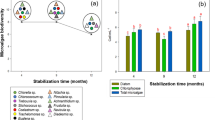Abstract
The purpose of this study is to evaluate the combined Cr(VI) removal capacities of nonliving (untreated rubber wood sawdust, URWS) and living biomass (URWS-immobilized Acinetobacter haemolyticus) in a continuous laboratory scale downward-flow two column system. Synthetic solutions of Cr(VI) between 237 and 320 mg L−1 were mixed with 1 g L−1 brown sugar in a nonsterile condition. Final Cr(VI) of between 0 and 1.6 mg L−1 indicate a Cr(VI) removal capacity of 99.8–100%. The bacterial Cr(VI) reduction capacity increased with column length. This study shows the feasibility of using the two column system consisting of living (bacteria) and nonliving biomass (URWS) as a useful alternative treatment for Cr(VI) contamination in the aqueous system.



Similar content being viewed by others
References
Chen, Y., & Gu, G. (2005). Preliminary studies on continuous chromium (VI) biological removal from wastewater by anaerobic–aerobic activated sludge process. Bioresource Technology, 96, 1713–1721. doi:10.1016/j.biotech.2004.12.024.
Chirwa, E. M. N., & Wang, Y. T. (1997). Chromium(VI) reduction by Pseudomonas fluorescens LB 300 in fixed-film bioreactor. Journal of Environmental Engineering, 123, 760–766. doi:10.1061/(ASCE)0733-9372(1997) 123:8(760).
Cushnie, G. C,. Jr. (1985). Electroplating wastewater pollution control technology. Park Ridge, NJ: Noyes.
Ekenberg, M., Martander, H., & Welander, T. (2005). Biological reduction of hexavalent chromium—a field study. Water Environment Research, 77, 425–428. doi:10.2175/106143005X52175.
Gardea-Torresdey, J. L., Tiemann, K. J., Armendariz, V., Bess-Oberto, L., Chianelli, R. R., Rios, J., et al. (2000). Characterization of Cr (VI) binding and reduction to Cr (III) by the agricultural byproducts of Avenamonida (oat) biomass. Journal of Hazardous Materials, 80, 175–188. doi:10.1016/S0304-3894(00)00301-0.
Greenberg, A. E., Trussell, R. R., & Clesceri, L. S. (1998). Standard methods for the examination of water and wastewater (16th ed.). New York, NY: APHA.
Hamadi, N. K., Chen, X. D., Farid, M. M., & Lu, M. G. Q. (2001). Adsorption kinetics for the removal of chromium(VI) from aqueous solution by adsorbents derived from used tyres and sawdust. Chemical Engineering Journal, 84, 95–105. doi:10.1016/S1385-8947(01)00194-2.
Holt, J. G., Krieg, N. R., Sneath, P. H. A., Stanley, J. T., & William, S. T. (1994). Bergey’s manual of determinative bacteriology (9th ed.). New York, NY: Williams and Wilkins.
Karthikeyan, T., Rajgopal, S., & Miranda, L. R. (2005). Chromium(VI) adsorption from aqueous solution by Hevea Brasilinesis sawdust activated carbon. Journal of Hazardous Materials, B124, 192–199. doi:10.1016/j.jhazmat.2005.05.003.
Katz, S. A., & Salem, H. (1994). The biological and environmental chemistry of chromium. New York, NY: VCH.
Krishna, K. R., & Philip, L. (2005). Bioremediation of Cr(VI) in contaminated soils. Journal of Hazardous Materials, 121, 109–117. doi:10.1016/j.jhazmat.2005.01.018.
Liu, S. X., Chen, X., Chen, X. Y., Liu, Z. F., & Wang, H. L. (2007). Activated carbon with excellent chromium (VI) adsorption performance prepared by acid–base surface modification. Journal of Hazardous Materials, 141, 315–319. doi:10.1016/j.jhazmat.2006.07.006.
Lytle, C. M., Lytle, F. W., Yang, N., Qian, J.-H., Hansen, D., Zayed, A., et al. (1998). Reduction of Cr (VI) to Cr (III) by wetland plants: potential for in situ heavy metal detoxification. Environmental Science & Technology, 32, 3087–3093. doi:10.1021/es980089x.
Mecozzi, M. (2005). Estimation of total carbohydrate amount in environmental samples by the phenol–sulphuric acid method assisted by multivariate calibration. Chemometrics and Intelligent Laboratory Systems, 79, 84–90. doi:10.1016/j.chemolab.2005.04.005.
Megharaj, M., Avudaiyanagam, S., & Naidu, R. (2003). Toxicity of hexavalent chromium and its reduction by bacteria isolated from soil contaminated with tannery waste. Current Microbiology, 47, 51–54. doi:10.1007/s00284-002-3889-0.
Mohan, D., & Pittman, P. U,. Jr. (2006). Activated carbons and low cost adsorbents for remediation of tri- and hexavalent chromium from water. Journal of Hazardous Materials, B137, 762–811. doi:10.1016/j.jhazmat.2006.06.060.
Mohan, D., Singh, K. P., & Singh, V. K. (2005). Removal of hexavalent chromium from aqueous solution using low-cost activated carbons derived from agricultural waste materials and activated carbon fabric cloth. Industrial & Engineering Chemistry Research, 44, 1027–1042. doi:10.1021/ie0400898.
Park, D., & Park, J. M. (2006). Mechanisms of the removal of hexavalent chromium by biomaterials or biomaterial-based activated carbons. Journal of Hazardous Materials, B137, 1254–1257. doi:10.1016/j.jhazmat.2006.04.007.
Park, D., Yun, Y.-S., Jo, J. H., & Park, J. M. (2005). Mechanism of hexavalent chromium removal by dead fungal biomass of Aspergillus niger. Water Research, 39, 533–540. doi:10.1016/j.watres.2004.11.002.
Sciban, M., Radetic, B., Kevresan, Z., & Klasnja, M. (2007). Adsorption of heavy metals from electroplating wastewater by wood sawdust. Bioresource Technology, 98, 402–409. doi:10.1016/j.biortech.2005.12.014.
Shakoori, A. R., Makhdoom, M., & Haq, R. U. (2000). Hexavalent chromium reduction by a di Cr(VI)-resistant Gram-positive bacterium isolated from effluents of tanneries. Applied Microbiology and Biotechnology, 53, 348–351. doi:10.1007/s002530050033.
Wang, Y. T., & Xiao, C. (1995). Factors affecting hexavalent chromium reduction in pure cultures of bacteria. Water Research, 29, 2467–2474. doi:10.1016/0043-1354(95)00093-Z.
Zakaria, Z. A., Zakaria, Z., Surif, S., & Ahmad, W. A. (2007a). Hexavalent chromium reduction by Acinetobacter haemolyticus isolated from heavy-metal contaminated wastewater. Journal of Hazardous Materials, 146, 30–38. doi:10.1016/j.jhazmat.2006.11.052.
Zakaria, Z. A., Zakaria, Z., Surif, S., & Ahmad, W. A. (2007b). Biological detoxification of Cr(VI) using wood-husk immobilized Acinetobacter haemolyticus. Journal of Hazardous Materials, 148, 164–171. doi:10.1016/j.jhazmat.2007.02.029.
Acknowledgment
The authors acknowledge the contribution from the Ministry of Science, Technology and Innovation (MOSTI), Malaysia for funding of the project (TF0106B001) and for the Post-Doctoral Fellowship to Zainul Akmar Zakaria at Universiti Teknologi Malaysia (UTM). We are also thankful to Nordiana Nordin (for brown sugar characterization), Marlini Suratman, and Nurfadilah Mohammed (FESEM analysis).
Author information
Authors and Affiliations
Corresponding author
Rights and permissions
About this article
Cite this article
Ahmad, W.A., Zakaria, Z.A., Razali, F. et al. Evaluation of the Combined Cr(VI) Removal Capacity of Sawdust and Sawdust-Immobilized Acinetobacter haemolyticus Supplied with Brown Sugar. Water Air Soil Pollut 204, 195–203 (2009). https://doi.org/10.1007/s11270-009-0037-5
Received:
Accepted:
Published:
Issue Date:
DOI: https://doi.org/10.1007/s11270-009-0037-5




